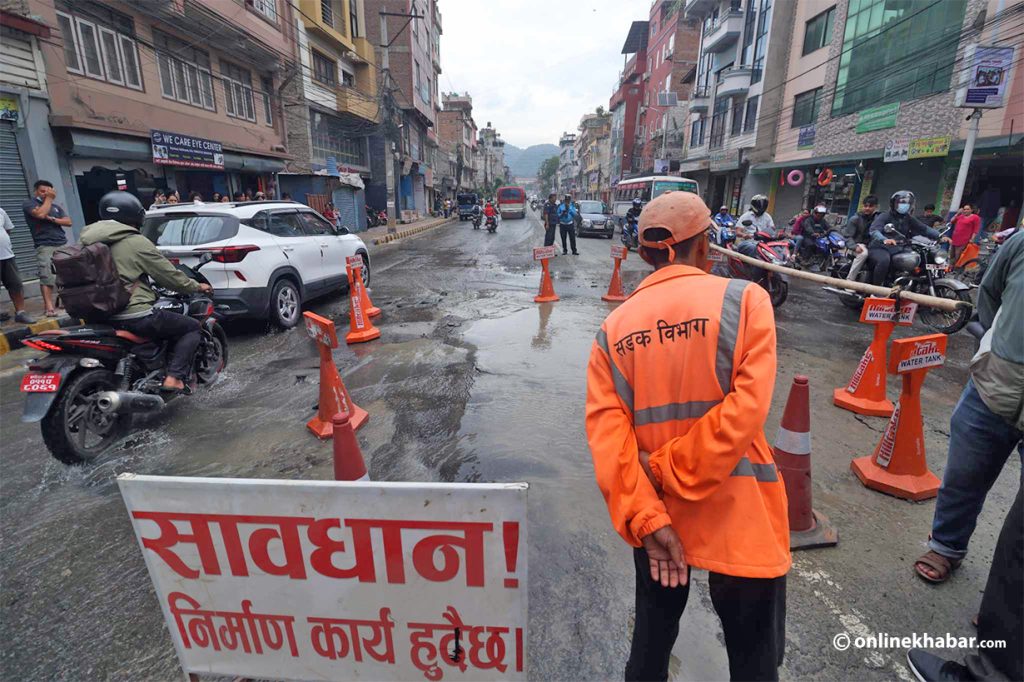
Rajesh is a resident of Satdobato, Lalitpur who frequently rides his scooter through the same neighbourhood where he lives. On Saturday afternoon, he was commuting back home after running some errands. The route he took was familiar to him, with known traffic patterns, local shops, and pedestrian traffic.
While approaching a familiar intersection near his home, Rajesh notices that the traffic light is about to turn red. Given his familiarity with the area, he decides to accelerate slightly to get through the intersection before the light changes. He feels confident and somewhat complacent, believing that he knows the traffic patterns well enough to safely make this manoeuvre.
However, as he approached the intersection, a pedestrian suddenly crossed the road from a nearby shop, catching Rajesh off guard. Due to his increased speed and sudden reaction, Rajesh was unable to stop in time and collided with the pedestrian.
The impact causes injuries to both Rajesh and the pedestrian, leading to significant consequences.
Less vigilant about potential hazards
Rajesh’s familiarity with the area led to a sense of overconfidence, causing him to underestimate the potential risks at the intersection. His decision to speed up to beat the traffic light demonstrates a common behaviour where drivers feel more comfortable in taking risks in familiar surroundings. Knowing the area well, Rajesh may have been less vigilant about potential hazards, such as unexpected pedestrian crossings.
The accident highlights the dangers associated with the close-to-home effect. Even though Rajesh was familiar with his route, the predictable patterns he relied on were disrupted by unforeseen circumstances. This case emphasizes the importance of maintaining vigilance and adherence to traffic rules, regardless of how well one knows a particular area.
Studies have found that a significant proportion of traffic accidents occur within a short distance of the driver’s home, often within 5-10 miles. For example, a report by the Insurance Information Institute, USA, found that about 52 per cent of accidents occur within 5 miles of a driver’s home, and 69 per cent within 10 miles.
In such cases, drivers may feel a false sense of security in familiar areas, leading to reduced vigilance and attention to potential hazards.
Overconfidence leads to danger
The close-to-home effect is often attributed to driver complacency. When drivers are in familiar surroundings, they may engage in riskier behaviours, such as speeding, ignoring traffic signals, or using their phones, because they feel more confident and less likely to encounter unexpected dangers.
Drivers tend to overestimate their safety when driving in areas they know well. This overconfidence can lead to behaviours like following too closely, making quick lane changes, or underestimating the risks posed by other road users. The assumption that familiar areas are inherently safer can result in drivers lowering their guard and making risky decisions.
Distracted driving is a significant factor in the close-to-home effect. In familiar areas, drivers may be more likely to engage in distracting activities, such as adjusting the radio, talking to passengers, or using a mobile phone, because they feel more comfortable and less focused on driving.
Psychological studies suggest that the close-to-home effect may also be linked to a cognitive bias where the brain is less engaged in routine familiar tasks. This automatic pilot mode reduces the mental resources dedicated to monitoring the driving environment. When the brain is less engaged in familiar tasks, it is more prone to missing unexpected events or changes in the driving environment, leading to accidents.
Studies from countries like the United States, the United Kingdom, and Australia have consistently shown that between 50 per cent to 70 per cent of all traffic accidents happen within 5 to 10 miles of the driver’s home. This suggests that drivers are more likely to be involved in an accident when driving on familiar roads.
Checking the blind spots
Research indicates that drivers tend to become complacent when navigating familiar routes. This complacency can manifest in behaviours such as speeding, distracted driving, and not wearing seat belts, all of which increase the likelihood of an accident. Studies have also found that drivers perceive familiar roads as less risky, which can lead them to engage in riskier behaviours. For example, they may be more likely to use a mobile phone, drive faster, or neglect to check blind spots because they assume they know the road conditions well.
The close-to-home effect is also linked to the duration of the trip. Short trips, often within the local neighbourhood, are perceived as low risk, which can result in drivers taking more liberties with traffic rules. Familiarity with the local road infrastructure, such as traffic signals, intersections, and road conditions, can lead drivers to make assumptions about the behaviour of other road users, increasing the chances of collisions.
Research has shown that residential areas, where drivers feel most at ease, are often the sites of frequent accidents due to the close-to-home effect. This is compounded by the presence of pedestrians, cyclists, and children playing, all of whom may be overlooked by complacent drivers.
Research has documented that drivers often have near-miss incidents close to home, but these are frequently dismissed as flukes rather than warnings. This underestimation of danger can reinforce the belief that driving near home is inherently safer.
Organisations such as the UK’s Royal Society for the Prevention of Accidents have highlighted the close-to-home effect in their safety campaigns, citing studies that show a spike in accidents near home and advocating for greater vigilance regardless of location.
While substantial research has been conducted globally, there is a need for more localised studies, particularly in countries like Nepal, to understand how the close-to-home effect manifests in different cultural and infrastructural contexts. By studying local driving behaviours and accident data, policymakers and safety advocates can develop more effective strategies to mitigate this risk and enhance road safety overall.
Reducing deaths caused by the close-to-home effect requires a multifaceted approach that includes driver education, improved road infrastructure, enforcement of traffic laws, and public awareness campaigns.
Opting for public awareness and education
Public Awareness and Education Initiatives are the most important remedy to launch campaigns that specifically address the close-to-home effect, emphasizing that familiarity with the road does not equate to safety. We can use real-life stories and statistics to make the risks more relatable. The messages are targeted to reduce common risky behaviours in familiar areas, such as speeding, distracted driving, and not wearing seat belts.
Reinforcement of the importance of staying vigilant, even on short trips. Incorporate the close-to-home effect into driver education and training programs. Such endeavour teaches drivers about the psychological factors that lead to complacency and how to counteract them.
Another remedy is to be done in infrastructure improvements to enhanced signage and road markings as we install clear, visible signage, and road markings, especially in residential areas. These can serve as reminders to drivers that they need to remain alert, even in familiar settings. The implementation of traffic calming measures like speed bumps, roundabouts, and chicanes in residential neighbourhoods needs to be done to encourage drivers to reduce their speed.
Research has also suggested that improved lighting can ensure that roads, especially in residential areas, are well-lit. Good lighting can improve visibility and reduce the likelihood of accidents. Strict Enforcement of Traffic Laws by Increasing police presence and traffic patrols in residential areas to enforce speed limits, and seat belt use, and discourage distracted driving. Use of technology like employ of speed cameras, red light cameras, and other automated enforcement tools to monitor and penalize traffic violations, particularly in areas prone to the close-to-home effect. Conducting random checks for seat belt usage, mobile phone use, and adherence to speed limits, even in areas perceived as safe or low-risk.
By encouraging mindful driving which promotes mindfulness and concentration while driving, particularly in familiar areas. This initiative encourages drivers to stay engaged and aware of their surroundings at all times.
Educating drivers on the dangers of multitasking, such as using a mobile phone or adjusting the radio, especially when driving on familiar routes where they might feel more relaxed. Routine check-ins encourage drivers to periodically reassess their driving habits, particularly when they are close to home. Simple practices like reducing speed or scanning intersections can significantly reduce risk.
By engaging communities in road safety initiatives and organizing neighbourhood watch programs focused on traffic safety or community-driven awareness events can also be a good initiative. As we work with local schools to educate children and parents about road safety, those who often walk or bike in residential areas, raising awareness can help reduce accidents.
We also can set up a neighbourhood watch or community group focused on monitoring and improving road safety in residential areas. This can include reporting issues like speeding or poor road conditions.

























